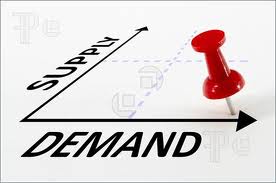- Introduction
- The demand for a particular commodity means the quality of a commodity which one acquires or is willing to acquire at a given price. Clearly, the demand for a commodity depends on a number of factors like price of the commodity, price of other commodities, income of the consumer, etc. An analysis of pattern of dependence of demand functions on such factors is very important for the government to control prices of essential commodities and to maintain overall economic stability in the market. As every government these days has to formulate some economic policy in order to have a balanced economic structure in the country, the subject-matter of demand analysis has gained considerable importance. The demand analysis deals with the following two aspects of Economic Statistics:
- i. To study the relationship between the demand and market price on the basis of market data (also called time series data).
- ii. To study the relationship between demand and income of the consumers on the basis of family budget data (also called cross-section data).
- The demand for a particular commodity means the quality of a commodity which one acquires or is willing to acquire at a given price. Clearly, the demand for a commodity depends on a number of factors like price of the commodity, price of other commodities, income of the consumer, etc. An analysis of pattern of dependence of demand functions on such factors is very important for the government to control prices of essential commodities and to maintain overall economic stability in the market. As every government these days has to formulate some economic policy in order to have a balanced economic structure in the country, the subject-matter of demand analysis has gained considerable importance. The demand analysis deals with the following two aspects of Economic Statistics:
- Demand and Supply
- In the theory of economics, mere desire for a commodity does not mean demand, unless one can pay and is willing to pay the necessary amount for it. By the term demand we mean the quantity of a commodity which one acquires or is able to acquire at a given price. Demand for any commodity depends on a number of factors such as the price of the commodity, the price of other commodities, income of the consumers, time, place, etc.
- “The functional relationship between consumption of a commodity and the factors responsible for the changes in consumption, is defined as the demand function of that commodity”. From this function, one can find different quantities of a commodity demanded at different prices.
- Similarly, the term supply means the amount of commodity available in the market at a given price. Obviously, if the market price is so low that the producer cannot realise the actual cost of production then he will not be interested in producing the required amount. Consequently, supply is also a function of the price at which commodity is sold in the market.
- Thus econometric study of the market data is made to determine the relation between:
- i. The price of a given commodity and its absorption capacity for the market, i.e., demand, and
- ii. The price of the commodity and its output, i.e., supply.
- Laws of Demand and Supply
- i. From the traditional concepts of Economics, the laws of demand and supply may be stated as follows:
“Demand for a commodity, in general, varies in the direction opposite to that of price whereas supply in general varies in the same direction as price.”
- ii. In other words, a rise in the price of a commodity results in decrease in its demand and increase in its supply and vice versa if the price falls down. According to A.A. Cournot (1801-1877), who first gave the mathematical formulation of the laws of demand and supply in a book published in France in 1838 and entitled “Research on the Mathematical Principles of the Theory of Wealth”, demand(d) is a certain function of price ‘p’, i.e., d=f(p), the only assumption regarding f(p) is that, as a rule, it is a diminishing function of ‘p’, i.e., f(p)<0.
- Price Elasticity of Demand
- One of the most important characteristics of demand function is what is known as its ‘elasticity’. According to the law of demand, the changes in price and demand are in opposite direction and it is a common experience that price changes affect the demand for different commodities in different degrees. In other words, the demand for some commodities is more sensitive to price changes than is the demand for others. For example, demand for necessities decreases very little when their prices rise whereas only a slight increase in the prices of luxuries will reduce their demand considerably. The quality of demand by virtue of which it extends or contracts with a fall or rise in price is known as ‘price elasticity of demand’, a term introduced by Marshall for evaluating the influence of variation in prices of the commodity on its demand. It shows the sensitiveness or responsiveness of demand to the changes in price.
Definition. Price elasticity of demand is defined as the value of the ratio of the relative (or proportionate) change in the demand to the relative (or proportionate) change in the price.
Click here for government certification in Accounting, Banking & Finance





4 Comments. Leave new
Good work!
good work!
Good explanation..
reminded my economic classes…